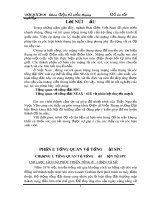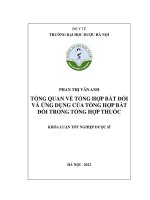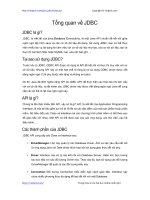Tổng quan về hệ kinh doanh điện tử
Bạn đang xem bản rút gọn của tài liệu. Xem và tải ngay bản đầy đủ của tài liệu tại đây (1.76 MB, 52 trang )
1
1
Ch
Ch
ươ
ươ
ng 1: Tổng quan về
ng 1: Tổng quan về
hệ
hệ
kinh
kinh
doanh
doanh
đ
đ
iện
iện
tử
tử
Học kỳ 1 – 2011-2012
Khoa
Khoa
Khoa
Khoa
Học & Kỹ Thuật Máy Tính
Học & Kỹ Thuật Máy Tính
Tr
Tr
ư
ư
ờng Đại Học Bách Khoa Tp. Hồ Chí Minh
ờng Đại Học Bách Khoa Tp. Hồ Chí Minh
Cao
Cao
Học
Học
Ngành
Ngành
Hệ
Hệ
Thống
Thống
Thông
Thông
Tin
Tin
Quản
Quản
Lý
Lý
Giáo
Giáo
trình
trình
đ
đ
iện
iện
tử
tử
Biên
Biên
soạn
soạn
bởi
bởi
: TS.
: TS.
Võ
Võ
Thị
Thị
Ngọc
Ngọc
Châu
Châu
(
(
)
)
2
2
Tài liệuthamkhảo
[1] In Lee, “Electronic Business: Concepts, Methodologies, Tools, and Applications”,
Idea Group Inc (IGI), 2008.
[2] Sanjiv Purba, “Architectures for E-Business Systems: Building the Foundation
for Tomorrow’s Success”, Auerbach Publications, 2002.
[3] Michael J. Shaw, “e-Business Management: State-of-the-Art Research,
Management Strategy, and Best Practices”, Kluwer Academic Publishers, 2002.
[4] W. S. Whyte, “Enabling eBusiness: Integrating Techologies, Architectures and
Applications”, John Wiley & Sons Ltd, 2001.
[5] Anne König, “E-Business@Print: Internet-Based Services and Processes”,
Springer-Verlag, 2005.
[6] Petter Gottschalk, “E-Business Strategy, Sourcing and Governance”,
Idea Group Inc (IGI), 2006.
[7] Winfried Lamersdorf, Volker Tschammer, Stéphane Amarger, “Building the E-
Service Society: E-Commerce, E-Business, and E-Government“, Kluwer Academic
Publishers, 2004.
[8] Janice Burn, Peter Marshall, Martin Barnett, “e-Business Strategies for
Virtual Organizations”, Elsevier Butterworth-Heinemann, 2002.
[9] Stuart Barnes, “E-Commerce and V-Business: Digital Enterprise in the Twenty-
First Century”, Second Edition, Elsevier, 2007.
[10] Colin Combe, “Introduction to e-Business: Management and Strategy”,
Elsevier, 2006.
[11] Nan Si Shi, V.K. Murthy, “Architectural Issues of Web−Enabled Electronic
Business”, Idea Group Publishing, 2003.
[12] In Lee, “Electronic Business: Concepts, Methodologies, Tools, and
Applications”, IGI Global, 2009.
3
3
Nộidung
Chương 1: Tổng quan về hệ kinh doanh
điệntử
Chương 2: Các chiếnlượckinhdoanhđiệntử
Chương 3: Các mô hình kinh doanh điệntử
Chương 4: Quảnlýkinhdoanhđiệntử
Chương 5: Dịch vụ hạ tầng cho các hệ kinh
doanh điệntử
Chương 6: Phát triểnhệ kinh doanh điệntử
Chương 7: Các vấn đề nghiên cứutrongcác
hệ kinh doanh điệntử
Chương 8: Ôn tập
4
4
Chương 1: Tổng quan về hệ kinh
doanh điệntử
1.1. Khái niệmvề kinh doanh/thương mại điệntử và
hệ kinh doanh điệntử
1.2. Ý nghĩavàvaitròcủahệ kinh doanh điệntử
trong mộttổ chức
1.3. Kiếntrúccủamộthệ kinh doanh điệntử
1.4. Các thành phầntrongmộthệ kinh doanh điện
tử
1.5. Ứng dụng củahệ kinh doanh điệntử trong các
qui trình và chứcnăng nghiệpvụ củamộttổ chức
1.6. Tóm tắt
5
5
1.1. Khái niệmvề kinh doanh/thương
mại điệntử và hệ kinh doanh điệntử
e-Business
e-Commerce
e-Business và e-Commerce
e-Business system
6
6
1.1. Khái niệm: e-Business
e-Business (Electronic Business)
Kinh doanh điệntử
“The use of the Internet to network (tạomạng lưới) and
empower (cho quyền) business processes, electronic
commerce, organizational communication (giao tiếp) and
collaboration (cộng tác) within a company and with its
customers (khách hàng), suppliers (nhà cung cấp), and
other stakeholders (ngườigiữ tiềngópvốn)”
[10], pp. 1.
“At its broadest, e-business is any type of business
transaction or interaction in which the participants operate
or transact business or conduct their trade electronically
.”
[11] , pp. 386.
7
7
1.1. Khái niệm: e-Business
e-Business (Electronic Business)
“e-business embodies the most pervasive (tỏakhắp),
disruptive (phá vỡ), and disconcerting (làm đảolộn) form
of change: it leaves no aspect of managing organisations
untouched, it challenges long-accepted business models,
and organisation leaders have little to draw on from their
past experience to manage its effects. In particular,
its
its
capacity to transform business processes is no longer in
capacity to transform business processes is no longer in
dispute
dispute (không còn bàn cãi nữa). ... Senior executives -
thus confront a central challenge (đương đầuthử thách
chính): How should they endeavour (cố gắng) to
capture,
capture,
analyse
analyse
, and project the transformational impact of e
, and project the transformational impact of e
-
-
business on their
business on their
organisation
organisation
’
’
s
s
most critical or core
most critical or core
processes
processes?”
[7], pp. 397-398
8
8
1.1. Khái niệm: e-Business
e-Business (Electronic Business)
“E-business is not just about selling a product over the Internet anymore - it
is about providing secured information to one’s customer(s) so that they can
make informed decisions that will ultimately impact the bottom line (điểmcốt
yếu). Whether a company is selling widgets to the public, feeding new product
information into a brokerage channel (kênh môi giới), or providing senior
management with production statistics,
e
e
-
-
business is about dissemination of
business is about dissemination of
information to the customer in a manner that allows them to use
information to the customer in a manner that allows them to use
it
it
effectively
effectively.”
[2], pp. 91.
“E-business is the overall business strategy that
redefines the old business
redefines the old business
models
models and
uses digital media and network technology to optimize customer
uses digital media and network technology to optimize customer
value delivery
value delivery. It relies on Internet-based computing, which is the platform
that supports the open flow of information between systems. It capitalizes on
an existing technology backbone (tậndụng cộttrụ công nghệ hiệncó)
consisting of front-end and back-end enterprise business systems, and
it makes effective use of component technology and interacts with customers
via business portals established over the Internet
. Technology is used in this
case both as the actual cause and also driver of business strategy. It is used
not only to develop the product or the service, but also to provide better
choices to customers and enhanced delivery options.”
[2], pp. 134.
9
9
1.1. Khái niệm: e-Business
e-Business (Electronic Business)
“The basic functionality of ERP and e-business
are different. Yet, ERP is an integrated software
packages system that handles an organisation’s
internal information whereas e-business is
fundamentally a distribution medium
and does
not involve a lot of processing. Although the
information flowing through e-business is
becoming more willing to process all of the time,
it is still processed by applications, and the best
business applications are still ERP and other
enterprise packages from major vendors.”
[12], pp. 67.
10
10
1.1. Khái niệm: e-Business
e-Business (Electronic Business)
“The term e-business has come into common use to cover
the use of Internet-based ICTs
within a company and
between businesses, customers, and suppliers.”
[12], pp. 159.
“E-business is an umbrella term referring to a wide
variety of Internet-based management solutions
. The
solutions considered here are: interactive Web sites (Web
sites có tính tương tác), e-commerce platforms (nềntảng
thương mại điệntử), e-procurement systems (hệ thống
thu mua hàng hoá điệntử), customer relationship
management systems (hệ quảntrị quan hệ khách hàng),
and telework (làm việctừ xa).”
[12], pp. 186.
11
11
1.1. Khái niệm: e-Business
e-Business (Electronic Business)
“The administration of conducting business via the Internet. This
would include the
buying and selling of goods and services
buying and selling of goods and services, along
with
providing technical or customer support
providing technical or customer support through the Internet
.
E-business is a term often used in conjunction with e-commerce,
but it includes services in addition to the sale of goods.”
[12], pp. 244.
“Electronic business (or e-business, for short) may be succinctly
defined as the ability to perform exchanges of goods, services,
content, assets and money, using electronic tools and techniques
”
[12], pp. 325.
“e-business is just
another form of business
another form of business, having the same
goals as any other business and requiring the convergence of
business capabilities in order to achieve those goals… The synergy
(hiệplực) of business and technology
is the single most important
characteristic of e-business.”
[12], pp. 326.
12
12
1.1. Khái niệm: e-Business
e-Business (Electronic Business)
“the use of the Internet to facilitate business-to-business
(B2B) or business-to-consumer (B2C) transactions and
includes all operations before and after the sale… the
adoption of the Internet to enable real-time supply-chain
collaboration and integration of the planning and execution
of the front-end and back-end processes and systems.”
[12], pp. 681.
“In addition to e-commerce activities, e-business includes
all other types of information exchanges. For example,
firms can use electronic means to distribute information
and provide after-sales service-in other words, “business”
activities as opposed to strictly “commercial” activities.”
[12], pp. 1063.
13
13
1.1. Khái niệm: e-Business
e-Business (Electronic Business)
“e-business refers to the incorporation of Internet
technologies into entire enterprise’s operations and
management.”
[12], pp. 1105.
“E-business is not just the sharing of business information,
maintaining business relationships, and conducting
business transactions by means of Internet-based
technology; it is also about the organisation’s social
environment and the relationships between people and
technologies
. Such a perspective highlights the complex
nature of the notion and shows that e-business goes
beyond e-commerce, in that when implemented
successfully, it transforms an organisation and its
capabilities entirely.”
[12], 1668.
14
14
1.1. Khái niệm: e-Business
e-Business (Electronic Business)
“E-business is not merely the use of
e-mail and Web sites – it includes
all the business processes that
can be made more efficient through
the Internet
.”
[12], pp. 2036.
15
15
1.1. Khái niệm: e-Commerce
e-Commerce (Electronic Commerce)
Thương mại điệntử
“the buying and selling, marketing and servicing
of products and services via computer
networks”
[10], pp. 1.
“The use of electronic transmission
(telecommunications) for exchange, sale and
purchase of goods and services. E-commerce
involves a transaction.”
[12], pp. 1063.
16
16
1.1. Khái niệm: e-Commerce
m-Commerce (Mobile Commerce)
Thương mạidiđộng
“Mobile e-business is a new way of advertising,
buying, selling and, in some cases, delivering
goods and services. It includes a range of
online business activities, business-to-business
and business-to-consumer, for products and
services through wireless devices
...”
[11], pp. 386.
17
17
1.1. e-Business và e-Commerce
e-Business = e-Commerce
e-Business ⊂ e-Commerce
e-Business ⊃ e-Commerce
18
18
1.1. e-Business và e-Commerce
e-Business = e-Commerce (phía công nghiệp)
e-Business ⊂ e-Commerce (x)
e-Business ⊃ e-Commerce (phía họcthuật)
Æ e-Commerce ⊆ e-Business (qui ước)
19
19
1.1. e-Business và e-Commerce
Figure 1.1. The relationship between e-business and e-commerce
[10], pp. 2.
20
20
1.1. e-Business và e-Commerce
Figure 2.1. E-commerce is part of e-business.
[6], pp. 16.
21
21
1.1. Khái niệm: e-Business system
e-Business: “
Electronic business has integrated
information systems
in business models.
”.
[6], pp. 334.
e-Business system
Hệ kinh doanh điệntử
Là mộtdạng củahệ thống thông tin (information
system)
Chiềungượclại không đúng.
Các hệ thống thông tin hỗ trợ kinh doanh điệntử
(information systems for e-business)
22
22
1.1. Khái niệm: information system
Hệ thống thông tin
A system that is ”a group of interrelated or
interacting elements forming a unified whole”
or “a group of interrelated components working
together toward a common goal by accepting
inputs and producing outputs in an organized
transformation process (dynamic system)”
with five resource components: people,
hardware, software, data, network
J. O’Brien. Management Information Systems: Managing
Information Technology in the Business Enterprise. Sixth
Edition. McGraw-Hill, 2004.
23
23
1.1. Khái niệm: information system
Hệ thống thông tin
A system that is ”a group of interrelated or
interacting elements forming a unified whole”
or “a group of interrelated components working
together toward a common goal by accepting
inputs and producing outputs in an organized
transformation process (dynamic system)”
with five resource components: people,
hardware, software, data, network
J. O’Brien. Management Information Systems: Managing
Information Technology in the Business Enterprise. Sixth
Edition. McGraw-Hill, 2004.
Hệ thống thông tin là mộthệ thống gồmnhiềuphầntử có mối liên hệ
với nhau hay là tương tác qua lạivới nhau nhằmtạothànhmộtthể
thống nhất.
Hệ thống thông tin là một nhóm các thành phầncómối liên hệ với
nhau cùng làm việcvới nhau vì mục tiêu chung bằng cách nhậnvào
thông tin nhậpvàtạo ra thông tin xuấttrongmộtquytrìnhbiến đổi
có tổ chứcnhư thể là mộthệ thống động.
Hệ thống thông tin gồmnămphần tài nguyên: con người, phầncứng,
phầnmềm, dữ liệu, và mạng.
24
24
1.1. Khái niệm: information system
Hệ thống thông tin
”An information system is a system for
collecting, processing, storing, retrieving,
and distributing information within the
enterprise and between the enterprise
and its environment.”
Peter Bernus, Günter Schmidt. Architectures of
Information Systems. In “Handbook on Architectures of
Information Systems”, eds. Peter Bernus, Kai Mertins,
Günter Schmidt, Springer, 2006.
25
25
1.1. Khái niệm: information system
Hệ thống thông tin
”An information system is a system for
collecting, processing, storing, retrieving,
and distributing information within the
enterprise and between the enterprise
and its environment.”
Peter Bernus, Günter Schmidt. Architectures of
Information Systems. In “Handbook on Architectures of
Information Systems”, eds. Peter Bernus, Kai Mertins,
Günter Schmidt, Springer, 2006.
Hệ thống thông tin là mộthệ thống nhằmhỗ trợ thu thập, xử lý, lưu
trữ, truy xuấtvàphânbố thông tin trong mộttổ chứcvàgiữatổ chức
đóvớimôitrường xung quanh củanó.









